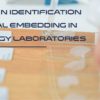No matter what type of histology laboratory you work in – hospital, research, reference, teaching facility – there will be times when you receive specimens that you do not normally receive. It is important to identify these specimens upon receipt, so that they can be handled correctly to avoid any sub-optimal event that may compromise the specimen and the resulting microscope slide.
Fingernail or toenail specimens are such specimens. Usually, the clinician suspects a fungal infection, however, in some cases, a malignant melanoma may be suspected. In either case, the nail must first be fixed thoroughly in formaldehyde. Upon receipt, it may be prudent to have the surgical grossing team use the “Nail Map’ (devised by Renig, et. Al.) shown in the “Handling of Nail Specimens” procedure contained herein, especially for nail bed specimens. Use of this map, along with proper inking, will help to maintain all three axes of orientation; epidermis-dermis, medial-lateral and proximal-distal.
After fixation, the nail should be held overnight in nail softening solution, which will soften and continue to fix the nail (5% Tween in 10% neutral buffered formalin). Decalcification solutions should not be used, as the hardness of the nail specimen is caused by keratin protein, not calcium. The following day, the specimen may be processed routinely into a paraffin block. It is important to use a “large side” processing protocol, not a “small” or “rush” protocol to ensure proper processing.
During cutting, additional unstained slides should be made for any special or immunohistochemical stains that the pathologist may want with the H&E stain. The use of the nail softening solution will make the microtomy go easier and result in optimal sections.
After cutting, the sections should be picked up on gelatin coated slides (or some other coated slide that works in your laboratory). This insures that the sections will adhere to the slide during H&E, periodic acid Schiff’s (PAS) and immunohistochemical staining. This will also help you avoid troubleshooting a “section fall off” event during staining.
Please notice that the literature describes the use of ammonium hydroxide solutions, “Nair”, and acid solutions for softening nails. Based on experience, these solutions are not recommended. The use of a 5% solution of Tween 85 (in formaldehyde) is recommended. Nail with an attached bone is a surgical pathology specimen and will require decalcification at some point.
The optimal mode of microtomy for nail specimens starts with optimal embedding. Nail specimens should be embedded on edge, at a 45 degree angle to the microtome knife edge. Hand wheel rotation should be slow, to avoid shattering the tissue. If nails continue to be “hard’ during microtomy, once the block face is opened and the nail tissue exposed, the entire block can be soaked for 15 to 30 minutes in the Tween solution described above, or in a simple detergent solution. Detergents act on the keratin proteins to soften them. Once sections are floated out, they should be picked up on gelatin coated slides. Extra slides should be picked up at this time for special stains requests.
Since the majority of nail specimens are taken for demonstration of possible fungi, the Periodic Acid Schiff’s (PAS) stain and the Gomori’s Methenamine silver (GMS) stain will most likely be requested. Nail specimens received for assessment of melanoma will require a Fontana-Masson stain along with other assorted immunohistochemical (IHC) stains (i.e. S-100, Melan-A, MITF). These unstained slides should be prepared at the time of initial microtomy to shorten turnaround times.
As with the previous blogs in this series, the best way to troubleshoot suboptimal events is to recognize exactly where in your laboratory these events could occur, and to address them “up front”. That is the case with nail specimens. In addition, it is important to be proactive in the embedding and microtomy tasks associated with any unique specimens that your laboratory may receive, which will further decrease chances for a suboptimal event to take place.
REFERENCES:
- Chapman, C.M. (2017). The Histology Handbook: In Search of the Perfect Microslide. Amazon CreateSpace Independent Publishing Platform
- Chapman, C.M. and Dimenstein, I.B. (2016). Dermatopathology Laboratory Techniques. Amazon CreateSpace Independent Publishing Platform
- Reinig et al. (2015) How to submit a nail specimen. Dermatologic Clinics: 33(2)
- Chapman, C.M. (2018). Troubleshooting in the Histology Laboratory. Submitted to J Histotechnol


